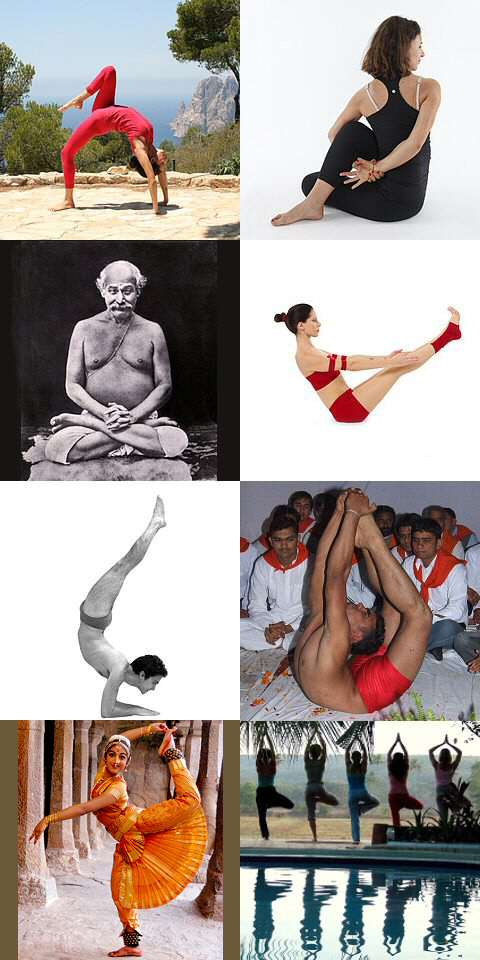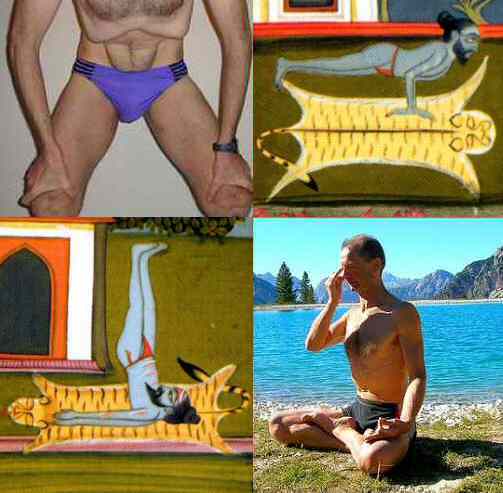|
Gorakshasana
Gorakshasana (, , Cowherd pose) is a seated asana in hatha yoga. It has been used for meditation and in tantric practice. Etymology and origins The pose is named for the sage Gorakhnath, founder of the nath yoga tradition, who is said to have used the pose for meditation. It is accordingly practised by his tantric devotees, the kanphata yogis. It is said to awaken kundalini and to halt the process of aging. The Sanskrit word () means "posture" or "seat". Gorakshasana is medieval in origin, described in hatha yoga texts including the 14th century ''Shiva Samhita'' 3.108-112, the 15th century ''Hatha Yoga Pradipika'' 1.28-29, and the 17th century ''Gheranda Samhita'' 2.24. Description Gorakshāsana is a seated pose with the soles of the feet pressed together and the knees on the ground, as in Baddha Konasana (in medieval times known as Bhadrasana), with the difference that the heels are under the body. Variations The pose is sometimes described as having the toes on t ... [...More Info...] [...Related Items...] OR: [Wikipedia] [Google] [Baidu] |
Asana
An āsana (Sanskrit: आसन) is a body posture, originally and still a general term for a sitting meditation pose,Verse 46, chapter II, "Patanjali Yoga sutras" by Swami Prabhavananda, published by the Sri Ramakrishna Math p. 111 and later extended in hatha yoga and modern yoga as exercise, to any type of position, adding reclining, standing, inverted, twisting, and balancing poses. The ''Yoga Sutras of Patanjali'' define "asana" as " position thatis steady and comfortable". Patanjali mentions the ability to sit for extended periods as one of the eight limbs of his system. Patanjali '' Yoga sutras'', Book II:29, 46 Asanas are also called yoga poses or yoga postures in English. The 10th or 11th century '' Goraksha Sataka'' and the 15th century '' Hatha Yoga Pradipika'' identify 84 asanas; the 17th century '' Hatha Ratnavali'' provides a different list of 84 asanas, describing some of them. In the 20th century, Indian nationalism favoured physical culture in response t ... [...More Info...] [...Related Items...] OR: [Wikipedia] [Google] [Baidu] |
Hatha Yoga
Hatha yoga (; Sanskrit हठयोग, International Alphabet of Sanskrit Transliteration, IAST: ''haṭhayoga'') is a branch of yoga that uses physical techniques to try to preserve and channel vital force or energy. The Sanskrit word हठ ''haṭha'' literally means "force", alluding to a system of physical techniques. Some hatha yoga style techniques can be traced back at least to the 1st-century CE, in texts such as the Hindu Itihasa, Sanskrit epics and Buddhism's Pali canon. The oldest dated text so far found to describe hatha yoga, the 11th-century ''Amritasiddhi, Amṛtasiddhi'', comes from a Tantra, tantric Buddhist milieu. The oldest texts to use the terminology of ''hatha'' are also Vajrayana Buddhist. Hindu hatha yoga texts appear from the 11th century onward. Some of the early hatha yoga texts (11th-13th c.) describe methods to raise and conserve bindu (vital force, that is, semen, and in women ''rajas –'' menstrual fluid). This was seen as the physical esse ... [...More Info...] [...Related Items...] OR: [Wikipedia] [Google] [Baidu] |
Lotus Position
Lotus position or Padmasana () is a cross-legged sitting meditation posture, meditation pose from History of India, ancient India, in which each foot is placed on the opposite thigh. It is an ancient asana in yoga, predating hatha yoga, and is widely used for meditation in Hinduism, Hindu, Tantra, Jainism, Jain, and Buddhism, Buddhist traditions. Variations include easy pose (Sukhasana), half lotus, bound lotus, and psychic union pose. Advanced variations of several other asanas including yoga headstand have the legs in lotus or half lotus. The pose can be uncomfortable for people not used to sitting on the floor, and attempts to force the legs into position can injure the knees. Shiva, the meditating ascetic God of Hinduism, Gautama Buddha, the founder of Buddhism, and the Tirthankaras in Jainism have been depicted in the lotus position, especially in statues. The pose is emblematic both of Buddhist meditation and of yoga, and as such has found a place in Western culture as ... [...More Info...] [...Related Items...] OR: [Wikipedia] [Google] [Baidu] |
Mulabandhasana
Mulabandhasana () is a sitting asana in hatha yoga. Etymology The name is from the Sanskrit , "root, base"; , "lock"; and , meaning "posture, seat". Description The pose is entered from the seated pose Baddha Konasana, in which the soles of the feet are pressed together and the knees rest on the floor. The feet are turned by grasping the toes to point the toes straight downwards, the heels upwards. In a variant, the feet are turned with the toes pointing backwards, when it becomes possible to sit on the outer sides of the feet, the heels remaining pressed together in front of the body. The body is balanced by the arms stretched straight down to the ground behind the back, the shoulder blades pressed together. Claimed effects The yoga master B. K. S. Iyengar claimed in his 1966 book ''Light on Yoga'' that Mulabandhasana helps to control excessive sexual desire. Mula Bandha, which can be practised also in other asanas, is one of the three principal bandhas, along with Jalandh ... [...More Info...] [...Related Items...] OR: [Wikipedia] [Google] [Baidu] |

